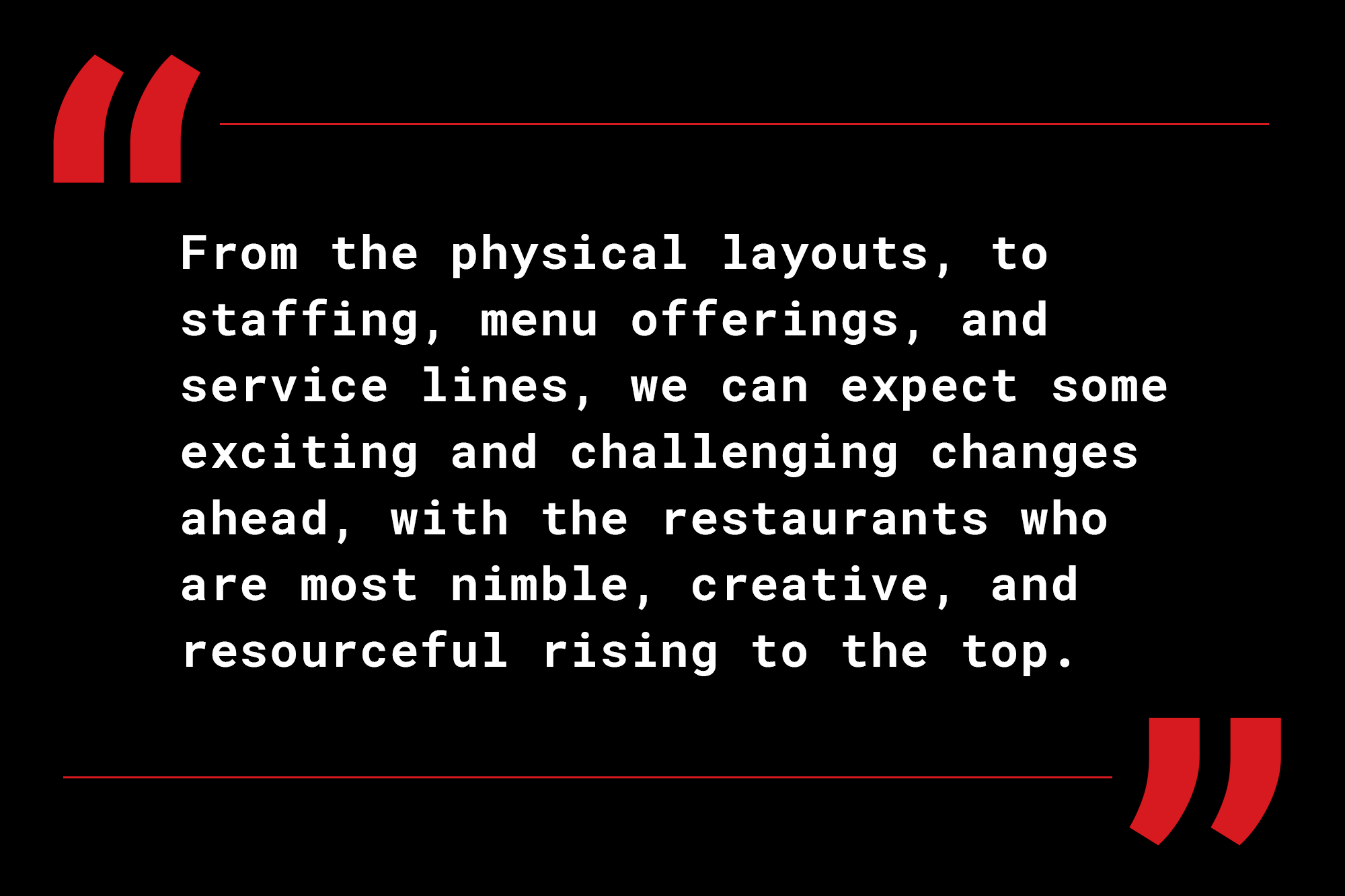What Does a Post COVID-19 Full-Service Restaurant Look Like?
It’s no secret that coming out of this stay-at-home environment the restaurant industry will look very different – both in the short term and likely permanently – for those full-service restaurants that survive. But what changes can we expect to see?
The full-service restaurants who made the decision to remain “open” in the midst of this pandemic have all adopted new business models, crafted new revenue streams, and got creative in their marketing. All of them have “upped” their game in an effort to dull the damage to their annual sales and retain their staff. We have seen robust delivery menus offering meals, bulk produce boxes, and even essential products like the highly coveted toilet paper rolls. We’ve seen socially distant and contact-less takeout operations that are newly set up at the front of establishments. And we’ve seen an explosion of social media touch points, imagery/marketing, followers, shares, direct messaging, recipe shares, live Q&A’s with chefs, and “how-to” events at home. For almost all restaurants in Boston, this is being done with rent abated or significantly reduced, and allowing these restaurants and their staff to get by. So what happens when the stay-at-home advisory is lifted, restaurants can host patrons, and landlord’s eventually have to collect rent?
In a recent Selectmen’s meeting on Nantucket, a proposal was presented outlining regulations for the summer season for restaurants on the island for when the stay-at-home advisory is lifted. Those regulations stated that restaurants could only be at 40% max occupancy (that is, if patrons even feel safe enough to dine in establishments to reach 40% occupancy); have only two seatings for lunch and two for dinner; a hard close at 10pm; no live music or entertainment; barstools at 6’ apart; full sanitization between seatings; and staff to wear gloves and masks at all times. This is likely going to be a microcosm of what the restaurant and bar scene will look like throughout Greater Boston for the majority of what remains in 2020.
For the most part, the deal structure for full-service restaurants is based on simple math. Average ticket price, times number of seats, times number of seatings throughout the week. You take that general annual sales volume and back it into the annual gross rent at a healthy occupancy rate to figure out what a restaurant can comfortably pay in rent in order to be successful throughout the length of their lease term. Of course there are variabilities of this – rent abatements, escalations, percentage rent structures, TI sliding scales, etc., but for the most part it is that simple.
When the number of seats – both in the dining area, and bar since alcohol sales typically account for a large percentage of annual sales of the restaurant – is reduced to half or more than half AND the number of seatings within a day are capped to 4 or less, it becomes impossible for a full-service restaurant to operate the way it did pre-COVID19, pay rent, and make money. In most cases, it becomes impossible to break even at all. Not only will they need rent relief, they will need to add revenue streams to be in a position to survive in the long run, pay their staff and, for some, have a shot at being profitable.
Similar to what traditional retailers went through during the surge of the ecommerce world, full-service restaurants will have to become multi-dimensional. The most profitable and impactful retailers are the ones who perfected the omni-channel approach – they have flagship brick and mortar locations, a powerful online operation with both websites and apps, pointed social media influencers and marketing, social mission drivers, etc., that all work seamlessly together to yield a well-polished and well-heeled brand.
In my opinion, this is going to have to be the new approach of the full-service restaurant industry. Restaurateurs are going to have to ramp up their online presence with robust websites, possibly apps, and email touch-points. They will have to increase their takeout and delivery operations, which means possibly hiring their own delivery people in an attempt to cut out third party delivery costs in order to be profitable. In the short term, they will most definitely have to convert front of house space, that would be taken up by seats in a pre-covid19 world, to a dedicated takeout area. This will also require chefs to have “delivery friendly” food, so that it travels well and maintains quality once it gets to its destination. Some restaurants might adopt the meal delivery service permanently, as a way of mass-producing meals and meal components that customers can assemble and “finish off” in their own homes – similar to the Blue Aprons of the world, but branded by the individual restaurants. This will require increasing the back of house operations and potentially securing ancillary space with a ghost kitchen or commissary to meet the demand of customers. If done well, this offering could strike a good balance of marketing reaching the homes of customers, but also of satisfying the newly assumed trend of wanting to cook at home with family. And lastly, any successful restaurateur will have to have an effective and engaging social media presence, whereby the restaurant’s brand is targeting new customers and retaining loyalty of existing patrons. Done well this will give the human connection touchpoint between the restaurant and customers, which will inherently increase sales.
While I don’t have a crystal ball to predict exactly what this industry will look like in the coming months, years, and beyond, it doesn’t require one to know that a full-service restaurant will look and feel different from what we experienced pre-COVID19, in order to be successful. From the physical layouts, to staffing, menu offerings, and service lines, we can expect some exciting and challenging changes ahead, with the restaurants who are most nimble, creative, and resourceful rising to the top.




